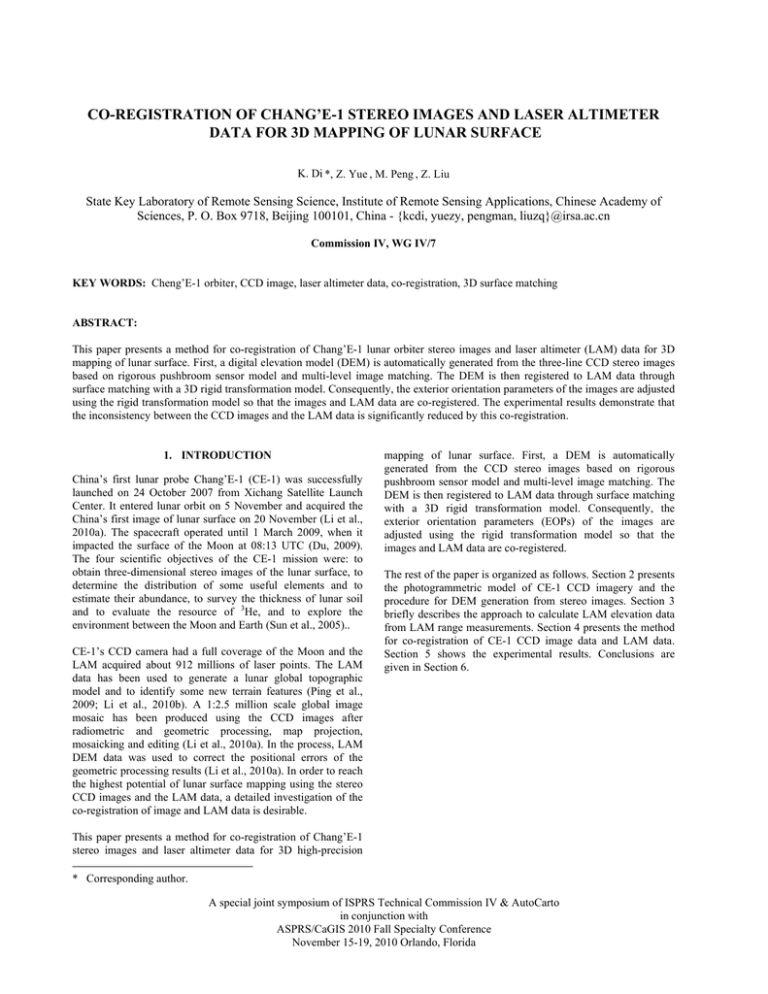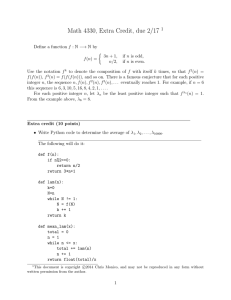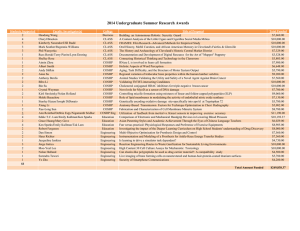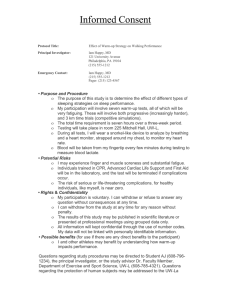CO-REGISTRATION OF CHANG’E-1 STEREO IMAGES AND LASER ALTIMETER
advertisement

CO-REGISTRATION OF CHANG’E-1 STEREO IMAGES AND LASER ALTIMETER
DATA FOR 3D MAPPING OF LUNAR SURFACE
K. Di *, Z. Yue , M. Peng , Z. Liu
State Key Laboratory of Remote Sensing Science, Institute of Remote Sensing Applications, Chinese Academy of
Sciences, P. O. Box 9718, Beijing 100101, China - {kcdi, yuezy, pengman, liuzq}@irsa.ac.cn
Commission IV, WG IV/7
KEY WORDS: Cheng’E-1 orbiter, CCD image, laser altimeter data, co-registration, 3D surface matching
ABSTRACT:
This paper presents a method for co-registration of Chang’E-1 lunar orbiter stereo images and laser altimeter (LAM) data for 3D
mapping of lunar surface. First, a digital elevation model (DEM) is automatically generated from the three-line CCD stereo images
based on rigorous pushbroom sensor model and multi-level image matching. The DEM is then registered to LAM data through
surface matching with a 3D rigid transformation model. Consequently, the exterior orientation parameters of the images are adjusted
using the rigid transformation model so that the images and LAM data are co-registered. The experimental results demonstrate that
the inconsistency between the CCD images and the LAM data is significantly reduced by this co-registration.
1. INTRODUCTION
China’s first lunar probe Chang’E-1 (CE-1) was successfully
launched on 24 October 2007 from Xichang Satellite Launch
Center. It entered lunar orbit on 5 November and acquired the
China’s first image of lunar surface on 20 November (Li et al.,
2010a). The spacecraft operated until 1 March 2009, when it
impacted the surface of the Moon at 08:13 UTC (Du, 2009).
The four scientific objectives of the CE-1 mission were: to
obtain three-dimensional stereo images of the lunar surface, to
determine the distribution of some useful elements and to
estimate their abundance, to survey the thickness of lunar soil
and to evaluate the resource of 3He, and to explore the
environment between the Moon and Earth (Sun et al., 2005)..
CE-1’s CCD camera had a full coverage of the Moon and the
LAM acquired about 912 millions of laser points. The LAM
data has been used to generate a lunar global topographic
model and to identify some new terrain features (Ping et al.,
2009; Li et al., 2010b). A 1:2.5 million scale global image
mosaic has been produced using the CCD images after
radiometric and geometric processing, map projection,
mosaicking and editing (Li et al., 2010a). In the process, LAM
DEM data was used to correct the positional errors of the
geometric processing results (Li et al., 2010a). In order to reach
the highest potential of lunar surface mapping using the stereo
CCD images and the LAM data, a detailed investigation of the
co-registration of image and LAM data is desirable.
mapping of lunar surface. First, a DEM is automatically
generated from the CCD stereo images based on rigorous
pushbroom sensor model and multi-level image matching. The
DEM is then registered to LAM data through surface matching
with a 3D rigid transformation model. Consequently, the
exterior orientation parameters (EOPs) of the images are
adjusted using the rigid transformation model so that the
images and LAM data are co-registered.
The rest of the paper is organized as follows. Section 2 presents
the photogrammetric model of CE-1 CCD imagery and the
procedure for DEM generation from stereo images. Section 3
briefly describes the approach to calculate LAM elevation data
from LAM range measurements. Section 4 presents the method
for co-registration of CE-1 CCD image data and LAM data.
Section 5 shows the experimental results. Conclusions are
given in Section 6.
This paper presents a method for co-registration of Chang’E-1
stereo images and laser altimeter data for 3D high-precision
* Corresponding author.
A special joint symposium of ISPRS Technical Commission IV & AutoCarto
in conjunction with
ASPRS/CaGIS 2010 Fall Specialty Conference
November 15-19, 2010 Orlando, Florida
2. GEOMETRIC MODELING OF CCD IMAGERY AND
DEM GENERATION FORM STEREO IMAGES
2.1 Rigorous Geometric Modelling of CE-1 Stereo CCD
Imagery
Im
a
ge
ar
mo ea o
o n n th
where
xforward, yforward = focal plane coordinates in forward-looking
image
xnadir, ynadir = focal plane coordinates in nadir-looking image
xbackward, ybackward = focal plane coordinates in backwardlooking image
xp, yp = center position (511.5, 255.5) of the actual imaging
area
x0, y0 = principle point position in the focal plane frame
pixelsize = size of per pixel in CCD (0.014 mm)
col = pixel position in column direction
It is worth to note that xforward, xnadir, and xbackward are fixed for
all the image lines of forward-, nadir- and backward-looking
images respectively due to the pushbroom imaging principle.
e
Figure 1. CE-1 stereo camera imaging configuration
The CE-1 CCD camera is a three line pushbroom camera which
is implemented on an area array CCD sensor. The CCD array
has 1024× 1024 pixels, with each pixel being 14 μm ×14 μm
in the chip. The forward-, nadir- and backward-looking images
of the Moon are generated by reading the 11th, 512th and
1013th rows that are perpendicular to the flight direction
(Figure 1). The convergence angle between the adjacent views
is 16.7° . At a 200 km altitude, the image spatial resolution is
120 m and the swath width is about 60 km. The focal length of
the CCD camera is 23.33 mm.
In order to transform the focal plane frame to the lunar bodyfixed frame (LBF) for topographic mapping, the EOPs of each
image line should be obtained by interpolation using the
spacecraft’s trajectory and pointing vectors. Since the orbit
trajectory data are defined in J2000 frame, they are firstly
transformed from J2000 to LBF using Equations (2).
INS
J 2000
RIAU
= RJINS
2000 RIAU
(2)
J 2000
AIAU = AJ 2000 RIAU
where
INS
RIAU
= orientation of CCD image in LBF
RJINS
2000 = orientation of CCD image in J2000
J 2000
RIAU
= rotation matrix from J2000 to LBF
AJ 2000 = position of CCD perspective center in
J2000
Forward
AIAU = position of CCD perspective center in LBF
y
Polynomials can be used to model the change of EOPs of the
image lines of a pushbroom sensor (Yoon and Shan, 2005;
Shan et al., 2005). Here we use third order polynomial to model
the EOPs of the CE-1 CCD images.
Nadir
O
X (t ) = a0 + a1t + a2 t 2 + a3t 3
Y (t ) = b0 + b1t + b2 t 2 + b3t 3
Z (t ) = c0 + c1t + c2 t 2 + c3t 3
Backward
x
ω (t ) = d 0 + d1t + d 2 t 2 + d3t 3
Figure 2. Focal plane frame of the CE-1 CCD
The actual imaging area is 1024 rows by 512 columns. The
focal plane frame is shown in Figure 2. The pixel coordinates
are transformed to the focal plane frame with the following
equations.
xbackward = ( x p − 11) * pixelsize − x0
xnadir = ( x p − 512) * pixelsize − x0
x forward = ( x p − 1013) * pixelsize − x0
(1)
(3)
ϕ (t ) = e0 + e1t + e2 t 2 + e3t 3
κ (t ) = f 0 + f1t + f 2 t 2 + f 3t 3
where
X(t), Y(t), Z(t) = position of the perspective center of
the sensor at time t
ω (t ), ϕ (t ), κ (t ) = pointing angles at time t
a0 , , f 3 = polynomial coefficients
t = acquisition time of each line
ybackward = ynadir = y forward = ( y p − col ) * pixelsize − y0
A special joint symposium of ISPRS Technical Commission IV & AutoCarto
in conjunction with
ASPRS/CaGIS 2010 Fall Specialty Conference
November 15-19, 2010 Orlando, Florida
To check the applicability and accuracy of third order
polynomials, we examined the trajectory and pointing data of
Orbit 562 (acquired between 00:23:32.001 and 00:26:22.00 on
Oct 26, 2007). For comparison purposes, we used both second
and third order polynomials. The residuals of the trajectory and
pointing data are shown in Figure 3, and the root mean square
errors (RMSEs) are listed in Table 1.
Image
preprocessing
Interest point
extraction
Interest point
Matching
Feature
matching
Left/right consistency
check
Gross error
elimination using
RANSAC
Dense
matching
Grid matching
Parallax prediction
TIN generation
Least squares matching
Figure 4. Multi-level stereo image matching
Figure 3. Residuals of polynomial fitting for orbit trajectory
and pointing data
Polynomial
order
2
3
Position(meter)
X
Y
Z
6.03
0.23
3.82
0.14
15.4
0.57
Matching error detection is performed using left/right
consistency check. As shown in Figure 5, from left image to
right image, P1 matches Q1, and P2 matches Q2; from right
image to right image, Q1 matches P1, and Q2 matches P2.
Through the left/right consistency check, (P1, Q1) are accepted
as correct matches, while (P2, Q2) and (Q2, P3) are discarded
as mismatches.
Orientation (second)
Ω
φ
Κ
0.45
0.09
0.72
0.02
53.59
7.62
Table 1. RMSE of polynomial fitting of EOPs
Figure 5. Left/right consistency check
From the figures and the table, it can be easily observed that
third order polynomials are much better than second order
polynomials in modelling the EOPs. Thus, third order
polynomial is adopted in this research.
To ensure the reliability of interest point matching, a RANSAC
process is applied to further eliminate possible gross errors
(mismatches) using a 2D similarity transformation model.
After the above geometric modelling process, rigorous
collinearity equations are established fro each image line of
forward-, nadir- and backward-looking images.
2.2 Multi-level Matching of CE-1 Stereo Images
To produce DEM from CCD stereo images after rigorous
modelling, we have developed a multi-level image matching
method. The flowchart is shown in Figure 4. Image preprocessing is done using Gaussian filter to remove noises.
Interest points are generated by Förstner operator and matched
using normalized correlation coefficients.
⎡ xr ⎤ ⎡ a − b ⎤ ⎡ xl ⎤ ⎡ c ⎤
⎢ ⎥+
⎢ y ⎥ = ⎢b
a ⎥⎦ ⎣ yl ⎦ ⎢⎣ d ⎥⎦
⎣ r⎦ ⎣
(4)
where
xl,yl = image coordinates of left (forward-looking) image
xr,yr = image coordinates of right (backward-looking)
image
a,b,c,d = transformation coefficients
After matching of interest points, a triangulated irregular
network (TIN)-controlled dense image matching method (Li et
al., 2007) is adopted for dense grid matching of CE-1 stereo
images. Firstly, a TIN is generated from the matched interest
points on the left image, and the x- and y- parallaxes are
calculated at each vertex. Second, a grid of 3× 3 pixels is
generated in the left image and the homologous image point of
each grid point on the right image is predicted using linear
interpolation of parallaxes from vertices of the triangle that
covers the grid point. The actual homologous point in the right
A special joint symposium of ISPRS Technical Commission IV & AutoCarto
in conjunction with
ASPRS/CaGIS 2010 Fall Specialty Conference
November 15-19, 2010 Orlando, Florida
image is determined by cross correlation within a small search
range from the predicted position. At last, least squares
matching method is applied to reach sub-pixel accuracy.
After image matching, 3D positions of the matched points are
calculated using space intersection with the collinearity
equations. The final DEM was generated using Kriging
interpolation.
3. PROCESSING OF LAM DATA
Using 1064 nm laser wavelength, CE-1’s LAM has a 200 meter
footprint and 5 meter ranging resolution. The along-track point
spacing is 1.4 km and the cross-track spacing is about 7 km at
the equator. Overall, more than 1000 orbits of LAM data with a
total of 9,120,000 points covering the entire lunar surface were
obtained.
Figure 6 shows a diagram of LAM ranging and elevation
calculation (Ping et al., 2009). In the figure, u is a laser
altimeter measuring vector at a certain measuring time, which
is determined by the altimetry ranging and its corresponding
attitude; RS is the selenocentric position vector of the satellite,
which is derived from spacecraft trajectory; R is the mean
radius of the Moon. The selenocentric position vector RG of the
light spot can be computed by combining u and RS;
subsequently, the elevation h of the light spot can be calculated
by referencing RG to the datum R.
of the CCD images can be improved using the LAM data as
ground control.
We use the iterative closest point (ICP) algorithm (Besl and
McKay, 1992) for registration of DEM to LAM point cloud. As
represented in Equation (5), the goal of the ICP algorithm is to
minimize the sum of square errors with respect to the CCD
DEM points and the corresponding closest LAM points. In
order to stabilize the ICP solution, a LAM DEM is generated
from the LAM point cloud by Kriging interpolation. In each
iteration step, the algorithm selects the closest points as the
correspondences and re-calculates the rotation and translation
parameters (R, t) of the rigid transformation to minimize the
equation
Nm
Nd
F = min ∑∑ m − ( Rd + t )
R ,t
i
i =1
2
(5)
j
j =1
where mi =coordinates of the LAM DEM points
d = coordinates of the CCD DEM points
t = a 3×1 vector that describes the translations between the
i
two datasets
R = a 3×3 matrix that describes the rotations between the
two datasets
The procedure of the ICP algorithm is as follows.
Step 1. Initialize the rotation matrix R as a unit matrix and
translation vector as 0.
Step 2. Search the closest point pairs between the CCD DEM
and the LAM DEM. Suppose there are N pairs of points found.
Step 3. The coordinates of the point pairs in the two datasets are
centralized using Equation (6) in order for stabilization of the
solution.
1
N
∑m
1
N
∑d
m =m −
'
i
i
d =d −
'
i
i
N
(6)
i
i =1
N
i
i =1
Step 4. Find R1 to minimize F′ by a SVD based method (Arun
et al., 1987); calculate t1 with Equation (8).
2
N
F′ = min ∑ m − R * d
'
R1
Figure 6. A diagram of LAM ranging and elevation calculation
i
1
'
i
(7) t1 =
i =1
1
N
4.1 Co-registration based on 3D Surface Matching
The purpose of CCD and LAM data co-registration is to reduce
the inconsistency between the two datasets so that to achieve a
higher mapping accuracy. As a result, the accuracy of the EOPs
i
R = R *R
t = R *t + t
1
i =1
i =1
(9)
1
Step 6. Use (R, t) to update the CCD DEM points.
d i = Rd i + t
(10)
Step 7. Repeat Steps 2 to 6 until the termination condition is
met, i.e., the change of the minimum distance (F′ ) between
two successive iterations is less than a threshold.
After the convergence of the ICP algorithm, the resultant (R, t)
parameters are applied the EOPs of the images so that the
A special joint symposium of ISPRS Technical Commission IV & AutoCarto
in conjunction with
ASPRS/CaGIS 2010 Fall Specialty Conference
November 15-19, 2010 Orlando, Florida
N
1
Step 5. Use equation 9 to update (R, t).
1
4. CO-REGISTRATION OF CCD IMAGE DATA AND
LAM DATA
1
N
∑m − R N ∑d
i
(8)
subsequent photogrammetric measurement from the stereo
images will be of higher accuracy, i.e., more consistent with the
LAM data.
looking images respectively. As can be seen from this figure,
the projected LAM points are different from their true
homologous points, showing that the two datasets are not very
consistent.
4.2 Co-registration by Projecting LAM Points onto CCD
Images
Another method to register the LAM points and the CCD
images is to project the LAM points onto the images through
collinearity equations. If the CCD images and the LAM data
are perfectly consistent, the projected positions on the forward-,
nadir- and backward-looking images will be homologous points.
Differences of the projected points from the actual homologous
points reflect the co-registration errors between the two datasets.
Sine the EOPs of each image scan line vary, we have to search
the best scan line (for each LAM points) so that we can use its
EOPs to project the LAM point onto the image. We use binary
search strategy to reduce the searching window (start line
TS and ending line TE ) gradually to find the best scan line T.
Taking forward-looking image as an example, the search and
projection steps are as follows.
(0)
Step 1. The initial searching window is set to be TS
=1,
TE(0) =N, T (0) =Round((N+1)/2), where N is the number of
lines.
Step 2. Calculate the x coordinate in the forward-looking image
using collinearity equation (11) and the EOPs of T 0 .
x=−f
a1 ( X − X i ) + b1 (Y − Yi ) + c1 ( Z − Z i )
a3 ( X − X i ) + b3 (Y − Yi ) + c3 ( Z − Z i )
(1)
(0)
If dx=x-xforward<0, set TS = TS
TS(1)
=
Calculate T
(1)
T
=
(0)
(1)
, TE = T
,
Round ((TS(1)
(0)
TE(1)
+ TE(1) ) / 2)
(11)
(a) Forward-looking image (b) Backward-looking image
Figure 7. LAM points overlaid on CCD stereo images
A 500 m resolution DEM is generated from the forward- and
backward-looking images automatically. Figures 8 and 9 show
3D views of the CCD DEM and the LAM points before and
after the co-registration respectively. Apparently, distances
between LAM points and the CCD DEM have been reduced
after the co-registration.
, otherwise, set
= TE(0)
.
.
Iterate
until
TS(i ) − TE(i ) is less than a threshold (e.g., 10 lines).
Step 3. Calculate the projected x values of the LAM point using
(i )
(i )
the EOPs of each scan line in the window from TS to TE and
compare with the ideal value xforward. Take the line with the
minimum absolute value of dx as the best line Tmin .
Step 4. Project the LAM point using the EOPs of Tmin . Repeat
the process for all LAM points.
Figure 8. DEM and LAM point cloud before co-registration
5. EXPERIMENTAL RESULTS
The developed method is tested using CE-1 stereo images of a
61km by 120 km area and 620 LAM points of 11orbits. The
area has an elevation range from -2759.8 m to 719.2 m,
referencing to the mean radius of 1737.4 km.
First, we project the LAM points onto the forward-, nadir-, and
backward-looking images using the EOPs from 3rd polynomial
fitting of trajectory and pointing data. Figure 7 shows a small
portion of LAM points overlaid on the forward- and backwardA special joint symposium of ISPRS Technical Commission IV & AutoCarto
in conjunction with
ASPRS/CaGIS 2010 Fall Specialty Conference
November 15-19, 2010 Orlando, Florida
Table 3. Co-registration accuracy in object space
Overall, the mean differences between the measurements from
the CCD stereo images and the LAM data have been
significantly reduced in both image and object space, which
demonstrates the effectiveness of the proposed co-registration
method. The RMSEs of the 3D discrepancies between the
stereo images and the LAM data seem relatively large (about
300 m in X, Y and Z directions). Since no crossover correction
has been applied to the LAM points, these discrepancies may
partially attribute to the internal inconsistencies among the
LAM points of different orbits. We expect to further improve
the co-registration results after the crossover analysis of LAM
data is performed.
Figure 9. DEM and LAM point cloud after co-registration
We use the following two methods to evaluate the coregistration accuracy. (1) Taking the projected points in the
nadir-looking image as base points, calculate the discrepancies
between their homologous points (from image matching) and
the projected positions of the LAM points in the forward- and
backward-looking images respectively to depict the
inconsistencies between the imagery and LAM data. (2) Recalculate the 3D positions of LAM points from the projected
image points in the stereo images using space intersection, and
compare with the known LAM point coordinates.
Table 2 lists the discrepancies in image space before and after
the co-registration of the CCD DEM and the LAM data. We
can observe that the mean differences in the flight direction
(row) have been reduced from over two pixels to sub-pixel
level, while the differences in the cross-track direction and the
RMSEs remain about the same. This indicates that the coregistration has effectively eliminated the systematic error in
the flight direction. We can also observe that the discrepancies
are generally in opposite directions in the forward- and
backward-looking images.
6. CONCLUSIONS
It is necessary to register the stereo images and the LAM data
of CE-1 for high accuracy and consistent mapping of the lunar
surface. This will be more demanding when China’s next lunar
probe CE-2 acquires high-resolution stereo images for landing
site characterization and preparation for soft landing. A method
for co-registration of CE-1 stereo images and LAM data based
on 3D surface matching was proposed and tested in this paper.
The experimental results are promising. Further study
incorporating crossover analysis of LAM data and more
experiments will be performed.
ACKNOWLEDGEMENT
Funding of this research by National High Technology
Research and Development Program of China (2009AA12z310)
and National Natural Science Foundation of China (40871202)
is acknowledged. We thank the National Astronomical
Observatories of Chinese Academy of Sciences for providing
the experimental data.
REFERENCES
Forward (pixel)
Backward (pixel)
column row
column row
Before co- mean
1.60
2.25
-1.37
-2.59
registration RMSE 0.42
0.61
0.45
0.55
After co- Mean
1.58
0.21
-1.38
-0.58
registration RMSE 0.41
0.63
0.45
0.56
Table 2. Co-registration accuracy in image space
Table 3 lists the statistics of position differences in object space.
The mean differences are reduced from several hundred meters
to less than 20 meters. The RMSEs of the differences are only
slightly reduced.
ΔX(m)
Before coregistration
After
coregistration
Mean
RMSE
Mean
RMSE
400.387
333.970
10.593
305.859
ΔY(m)
ΔZ(m)
-227.359
295.564
1.625
291.513
492.835
325.414
-17.526
298.568
Arun, K., T. Huang, S. Blostein, 1987. Least Square Fitting of
Two 3-d Point Sets. IEEE Transactions on Pattern Analysis
and Machine Intelligence, 9(5), pp. 698-700.
Besl, P., N. McKay, 1992. A Method for Registration of 3-d
Shapes. IEEE Transactions on Pattern Analysis and Machine
Intelligence, 14(2), pp. 239-256.
Du, G., 2009. China's lunar probe Chang'e-1 impacts moon.
http://news.xinhuanet.com/english/200903/01/content_10923205.htm (accessed 1 sep. 2010)
Li, R., K. Di, A.B. Howard, L.H. Matthies, J. Wang, and S.
Agarwal, 2007. Rock modeling and matching for autonomous
long-range Mars rover localization, Journal of Field Robotics,
24(3), pp. 187-203.
Li, C., J. Liu, X. Ren, L. Mou, Y. Zou, H. Zhang, C. L, J. Liu,
W. Zuo, Y. Su, W. Wen, W. Wen, B. Zhao, J. Yang, X. Zou, M.
Wang, C. Xu, D. Kong, X. Wang, F. Wang, L. Geng, Z. Zhang,
L. Zheng, X. Zhu, J. Li, 2010a. The Global Image of the Moon
A special joint symposium of ISPRS Technical Commission IV & AutoCarto
in conjunction with
ASPRS/CaGIS 2010 Fall Specialty Conference
November 15-19, 2010 Orlando, Florida
by The Chang’E-1: Data Processing and Lunar Cartography.
Sci China Earth Sci, 53(8), pp. 1091-1102, doi:
10.1007/s11430-010-4016-x.
Li, C., X. Ren, J. Liu, X. Zou, L. Mou, J. Wang, R. Shu, Y. Zou,
H. Zhang, C, Lv, J. Liu, W. Zuo, Y. Su, W. Wen, W. Bian, M.
Wang, C. Xu, D. Kong, X. Wang, F. Wang, L. Geng, Z. Zhang,
L. Zheng, X. Zhu, J. Li, 2010b. Laser Altimetry Data of
Chang’E-1 and the Global Lunar DEM model. Sci China Earth
Sci (in Chinese), 40(3), pp. 281-293, doi: 10.1007/s11430-0100054-7.
Ping, J., Q. Huang, J. Yan, J. Cao, G. Tang, R. Shu, 2009.
Lunar Topographic Model CLTM-s01 from Chang’E-1 Laser
Altimeter. Sci China Ser G-Phys Mech Astron, 52(7), pp. 1105–
1114.
Shan, J., J. Yoon, D. Lee, R. Kirk, G. Neumann, C. Acton,
2005. Photogrammetric Analysis of the Mars Global Surveyor
Mapping Data. Photogrammetric Engineering and Remote
Sensing, 71(1), pp. 97-108.
Sun, H., S. Dai, J. Yang, J. Wu and J. Jiang, 2005. Scientific
objectives and payloads of Chang’E-1 lunar satellite. Journal of
Earth
System
Science,
114,
pp.
789–794.
doi:10.1007/BF02715964.
Yoon, J., J. Shan, 2005. Combined Adjustment of MOC Stereo
Imagey and MOLA Altimetry Data. Photogrammetric
Engineering and Remote Sensing, 71(10), pp. 1179-1186.
A special joint symposium of ISPRS Technical Commission IV & AutoCarto
in conjunction with
ASPRS/CaGIS 2010 Fall Specialty Conference
November 15-19, 2010 Orlando, Florida





